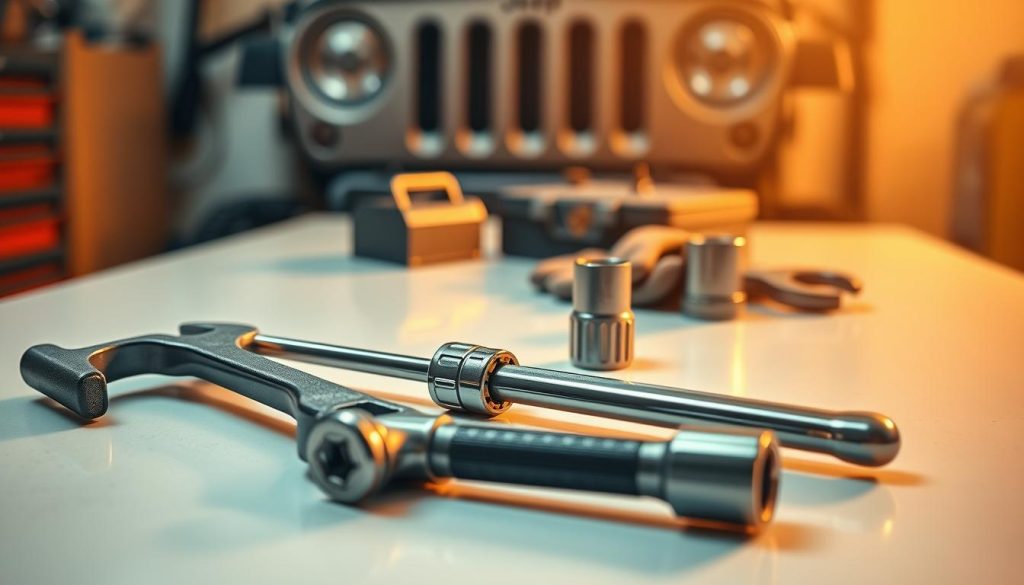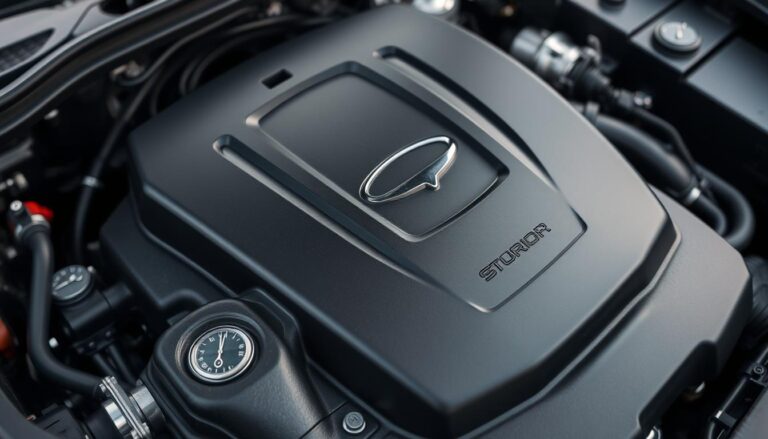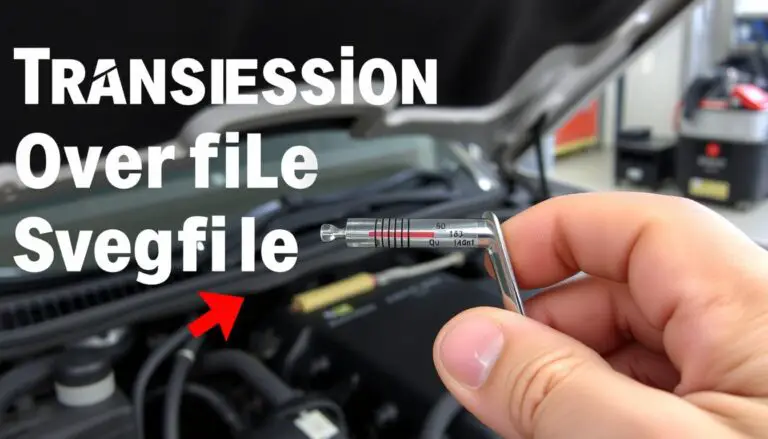Accessing your Jeep’s engine compartment is paramount for maintenance and repairs. The process is straightforward, and this guide will walk you through it. Understanding the hood release mechanism is crucial for easy access.
To initiate, locate the hood release lever inside your vehicle, typically on the driver’s side near the floor. For more detailed information on car hood mechanisms, you can visit this resource. Pull or press the lever until you hear a popping or clunking noise, indicating the hood is released.
Key Takeaways
- Locate the hood release lever inside the vehicle.
- Pull the lever to release the hood.
- Find the latch hook to unlatch the hood.
- Lift the hood and use a strut or prop rod to hold it in place.
- Regular maintenance can prevent the hood from getting stuck.
Understanding Your Jeep’s Hood Mechanism
The hood latch system of your Jeep is a complex assembly that necessitates a foundational comprehension to operate efficaciously. This acumen is crucial for accessing the engine and other components beneath the hood.
Basic Components of a Jeep Hood Latch System
The Jeep hood latch system comprises several pivotal components, including the release lever, latch, and safety catch. The release lever, situated within the vehicle, when activated, triggers the latch, permitting the hood to open. The safety catch serves as a secondary mechanism, ensuring the hood remains open while you’re under it.

Differences Between Jeep Models and Years
Diverse Jeep models and years exhibit variations in their hood latch systems. For instance, the Wrangler and Gladiator models possess a distinct hood release mechanism compared to the Cherokee and Grand Cherokee. Grasping these distinctions is imperative for successful hood opening. It is crucial to familiarize oneself with the specific hood latch system of one’s Jeep model to circumvent any confusion or difficulties.
Preparing to Open Your Jeep Hood
Initiating the process of opening your Jeep’s hood necessitates a preparatory phase, encompassing a series of critical checks and the acquisition of requisite tools.
Safety Precautions Before Opening
First and foremost, ensure your Jeep is positioned on a level surface and that the parking brake is engaged. This measure is paramount to prevent vehicular movement and mitigate the risk of physical harm. Subsequently, confirm that the engine is in a state of dormancy and has undergone sufficient cooling to preclude the possibility of thermal burns or injuries.
Tools You Might Need
The necessity for specific tools may vary based on your Jeep’s model. Typically, a screwdriver or pliers is required to disengage the hood latch. It is advisable to refer to your owner’s manual for precise guidance on the tools and methodologies appropriate for your vehicle.

How to Open Jeep Hood: Step-by-Step Instructions
Understanding the procedure to open your Jeep’s hood is paramount, whether for routine oil checks or more extensive maintenance. This operation, though seemingly complex, is in reality a series of elementary actions that can be mastered with diligence. Adherence to these guidelines will empower you to effortlessly access your vehicle’s engine compartment.
Locating the Interior Hood Release Lever
The initial step towards opening your Jeep’s hood is identifying the interior hood release lever. Situated beneath the steering column, this lever serves as the primary trigger for the hood’s release. Its activation is achieved through a simple pull, commencing the hood’s opening sequence.
Accessing and Releasing the Safety Latch
Following the lever’s activation, you must proceed to the front of your Jeep to engage the safety latch. This secondary mechanism is integral in preventing the hood from opening inadvertently. To liberate it, a gentle slide or lift to the side is required, facilitating the hood’s opening.
It is imperative to handle the safety latch with utmost care to prevent any potential damage. Should you encounter resistance, refrain from applying force, as this could signify a requirement for maintenance or repair.
Properly Lifting and Securing the Hood
Upon the safety latch’s release, the hood can be lifted. Most Jeep models are equipped with a prop rod, designed to maintain the hood in an open position. To accomplish this, elevate the hood to its full extent, then insert the prop rod into the designated slot. This action prevents the hood from falling, thus averting potential injury or damage.
Verify that the hood is securely propped open before embarking on any maintenance or inspections. This precaution ensures a safe environment under the hood.
Model-Specific Hood Opening Procedures
Diverse Jeep models necessitate a comprehension of their unique hood release mechanisms. The general procedure, encompassing the release of a latch and subsequent hood lifting, exhibits variability across models. This necessitates a model-specific approach to hood access.
Wrangler and Gladiator Hood Access
The Jeep Wrangler and Gladiator models boast a simplified hood release system. The interior release lever, situated under the dashboard, serves as the primary point of initiation. Upon its activation, the primary latch is released, prompting a subsequent step at the vehicle’s front to engage the safety latch. This configuration facilitates uncomplicated access to the engine compartment.
Cherokee and Grand Cherokee Hood Release Methods
The Cherokee and Grand Cherokee models introduce an additional layer to the hood release process. Following the activation of the interior release lever, a secondary latch at the vehicle’s front must be released. This step ensures the hood’s secure opening, preparing it for maintenance or inspection.
Compass, Renegade, and Liberty Models
The Compass, Renegade, and Liberty models, while sharing a similar hood release mechanism, may necessitate additional steps or present variations in latch design. It is imperative to refer to the owner’s manual for model-specific instructions, tailored to the vehicle’s model year.
| Jeep Model | Hood Release Steps | Additional Notes |
|---|---|---|
| Wrangler/Gladiator | 1. Pull interior lever; 2. Release safety latch | Straightforward design |
| Cherokee/Grand Cherokee | 1. Pull interior lever; 2. Release secondary latch | Additional safety latch |
| Compass/Renegade/Liberty | Varies by model year; consult owner’s manual | Model-specific instructions recommended |
Troubleshooting Common Hood Opening Problems
For Jeep owners, the ability to access the engine compartment efficiently is paramount. Issues such as a stuck or jammed hood latch, broken release cables, or other mechanical faults can hinder access.
Stuck or Jammed Hood Latch Solutions
A stuck or jammed hood latch is a common issue that can often be resolved by applying a suitable lubricant to the latch mechanism. If the latch remains stuck, gently manipulating it with a tool can help release it.
Dealing with Broken Release Cables
A broken release cable can prevent the hood from opening. In such cases, inspecting the cable for damage and replacing it if necessary is crucial. Sometimes, an emergency release method may be required.
Emergency Hood Opening Techniques
In situations where the hood release mechanism fails, using an emergency release technique can provide access to the engine compartment. This may involve accessing the latch directly or using specialized tools.
| Issue | Solution |
|---|---|
| Stuck Hood Latch | Lubricate or manipulate the latch |
| Broken Release Cable | Inspect and replace the cable |
| Hood Won’t Open | Use emergency release techniques |
Maintenance Tips for Smooth Hood Operation
Adherence to a rigorous maintenance regimen is paramount for the preservation of your Jeep’s hood functionality. A hood in pristine condition guarantees unhindered access to the engine, an indispensable aspect for both routine inspections and repairs.
Adherence to a consistent maintenance regimen is imperative for the uninterrupted operation of your Jeep’s hood. This regimen necessitates the periodic cleaning and lubrication of the hood latch and release mechanism.
Regular Cleaning and Lubrication Schedule
The regular cleansing of the hood latch and release mechanism is vital to avert the accumulation of dirt and grime, which can precipitate malfunctions. Employ a soft-bristled brush to dislodge any debris, followed by the application of a lubricant tailored to the specific materials of your Jeep’s hood latch system. This practice ensures the unhindered operation of the mechanism and mitigates the risk of premature wear.
Adherence to a lubrication schedule, ideally every six months or as stipulated in your Jeep’s owner’s manual, is crucial. The lubricant employed must be compatible with the materials constituting your Jeep’s hood latch system.
| Lubrication Interval | Lubricant Type | Application Method |
|---|---|---|
| Every 6 months | Silicone-based lubricant | Spray on moving parts |
| As needed | White lithium grease | Apply with a cloth |
When to Replace Hood Components
Components of the hood may deteriorate over time, necessitating replacement. Indicators of wear include a hood latch that is stuck or jammed, broken release cables, or visible wear on the hood hinges.
Upon detection of these symptoms, immediate replacement of the affected components is imperative to maintain the smooth operation of your Jeep’s hood.
Conclusion
Opening your Jeep’s hood is now a straightforward process, thanks to the steps outlined in this comprehensive guide. By understanding the specifics of your Jeep model and following the provided instructions, you’ll have easy access to your engine compartment. Regular Jeep maintenance is crucial for the longevity of your vehicle, and having a smooth hood operation is a significant part of this.
With the knowledge gained from this guide, you’re well-equipped to perform routine checks and more complex repairs. This not only saves time but also ensures that your Jeep remains in optimal condition. For more information on Jeep maintenance and other related topics, explore our resources to keep your vehicle running smoothly.
FAQ
How do I open my Jeep’s hood?
To initiate the process of opening your Jeep’s hood, first locate the interior hood release lever situated beneath the steering column. Upon pulling the lever, the hood’s mechanism is released, prompting you to proceed to the vehicle’s front. There, you will encounter the safety latch. Release this latch and then elevate the hood.
What are the basic components of a Jeep hood latch system?
The hood latch system of a Jeep encompasses several critical components. These include the release lever, the latch itself, and the safety catch. Mastery over these elements is essential for the successful operation of the hood opening mechanism.
Are there differences in hood latch systems between Jeep models and years?
Yes, the hood latch systems of various Jeep models and years exhibit distinct variations. For example, the Wrangler and Gladiator boast a unique hood release mechanism, differing from that of the Cherokee and Grand Cherokee.
What safety precautions should I take before opening my Jeep’s hood?
Before embarking on the task of opening your Jeep’s hood, ensure that your vehicle is positioned on a level surface and that the parking brake is firmly applied. Depending on your Jeep model, you may require basic tools such as a screwdriver or pliers.
How do I troubleshoot a stuck or jammed hood latch?
In the event of a stuck or jammed hood latch, consider applying lubricant or gently manipulating the latch to rectify the situation. Should the issue persist, professional intervention may be necessary.
What should I do if the release cable is broken?
Should the release cable be broken, replacement or the utilization of an emergency release method may be required. Consult your owner’s manual for specific guidance on proceeding.
How can I maintain smooth hood operation?
Ensuring the smooth operation of your hood hinges on regular maintenance. Cleaning and lubricating the latch and release mechanism will prevent the accumulation of dirt and grime, which can impede function. Lubrication of the moving parts is equally crucial for uninterrupted operation.
When should I replace hood components?
Over time, hood components may deteriorate, necessitating replacement. Any signs of wear or damage, such as rust or corrosion, should prompt the replacement of affected parts to maintain optimal hood operation.
Are there any model-specific hood opening procedures I should be aware of?
Yes, the hood opening procedures for different Jeep models exhibit unique characteristics. For instance, the Wrangler and Gladiator feature a straightforward release lever and latch system, whereas the Cherokee and Grand Cherokee require the release of a secondary latch.


